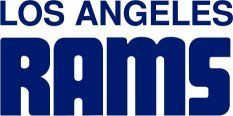Paul Lukas of Uni Watch looks at the origins of the Rams’ uniforms and discusses the team’s future in Los Angeles. (2:18)
Watch Lukas Talk Rams Unis
===============
Uni Watch's Friday Flashback: Evolution of the Rams' look
By Paul Lukas
ESPN.com
http://espn.go.com/nfl/story/_/id/1...back-evolution-rams-look-los-angeles-st-louis
With the St. Louis Rams moving back to Los Angeles, there's been a flurry of speculation as to whether the relocation will be accompanied by a uniform redesign. (We've even issued our own "Redesign the Rams" challenge.) That makes this a good time to take a Friday Flashback look at some of the key moments in Rams uniform history.
One of those is also a key moment in football history, period. That came in 1948, after the Rams' second season of their first stint in L.A. Halfback Fred Gehrke, who had studied art at the University of Utah, convinced coach Bob Snyder and owner Dan Reeves to let him paint ram horns on the team's headgear -- the first graphic ever to appear on an NFL helmet (further info here):
How has the Rams' look evolved since then? Here's a selected timeline featuring some of the team's more notable uniform designs -- some positive, some negative:
1949: For one season, the Rams experiment with a new color scheme, eliminating blue and adding red. The results look a lot like another L.A.-based team -- the USC Trojans:
1950: The Rams go back to blue and yellow. They will retain this color scheme for 14 seasons:
1953: The Rams enhance their uniform numbers with white outlining -- a sharp look that gives them the boldest uni numbers in the NFL:
1958: The Rams keep their blue/yellow color scheme but abandon their yellow jerseys, switching to white jerseys for road games. They won't wear yellow jerseys again until 1994 (as part of the NFL's 75th anniversary throwback series) and again in 2015 (as part of the league's Thursday night "Color Rush" promotion):
1964: The Rams abandon yellow entirely and switch to a simple blue-white color scheme, which they will maintain for nine seasons. For the first eight of those seasons, they choose to wear their white jerseys at home. Since they also wear white for most road games (due to most other teams choosing to wear their colored jerseys at home), the team's predominant look during this period is white over white, with the blue jerseys being worn only occasionally:
1973: Yellow is restored to the team's color scheme and is added to all parts of the uniform -- the helmet, the jersey, the pants and even the socks. In a clever touch, the horns on the helmet are echoed by a new set of horns on the shoulders and sleeves. The team also goes back to wearing blue jerseys for most home games. Aside from a few minor tweaks involving shoe colors and sock stripes, this remains the team's basic look for the rest of its time in Los Angeles:
1973-1984: Defensive end Jack Youngblood and linebacker Jim Youngblood (who, contrary to common belief, are not related) both play for the Rams. Since they have the same surname and the same first initial, they wear their full names on their jerseys. And since "Youngblood" has so many letters, their names are in the unusual double-decker format:
1983-1987: Running back Eric Dickerson establishes a distinctive signature style while playing for the Rams, becoming known for his goggles, his white neck roll and his Vettex mouth guard:
1995: The Rams move from L.A. to St. Louis and leave their uniforms unchanged except for a patch commemorating their first season in their new home:
2000: One season after winning Super Bowl XXXIV, the Rams get a makeover. Their shade of blue changes from royal to navy, and the yellow changes to gold. With NFL sleeves getting shorter, the shoulder horns are scrapped, and some unfortunate side panels are added to the jerseys. The new pants, interestingly, are solid gold with no striping -- an NFL rarity. The new look works well enough with the white jersey, but the blue jersey looks too drab:
2003: Blue pants -- this time with striping -- are added to the mix for a handful of road games. They lack the elegance of the gold pants:
2005: The full disaster potential of the blue pants is realized as the Rams go mono-blue for the first time in franchise history for a Week 11 game against the Cardinals. They reprise the look six weeks later and go on to feature it at least once (and often a lot more than once) in nine of the next 10 seasons, speeding their transition from one of the league's better-looking teams to one of its worst-looking.
2012: With Nike taking over the NFL's uniform contract, the Rams adopt one of sportswear giant's signature design accents: a contrasting collar panel that looks a bit like Eric Dickerson's old neck roll (or, as some fans quickly dub it, the "toilet seat collar"). Oddly, this design element is also included on the team's throwbacks despite being historically inaccurate. Meanwhile, the gold pants, which have been worn less and less, are officially mothballed.
And that pretty much brings us up to date, at least in terms of the major developments. If you want to see even more details, including a look at what the franchise wore when it was located in Cleveland back in the 1930s and '40s, check out the excellent Gridiron Uniform Database, where you can see the team's entire uniform history at a glance.
As for what the Rams will wear for their return to L.A., that remains to be seen. But if you have a good design idea for them, let's see it.
 [/QUOTE]
[/QUOTE]






